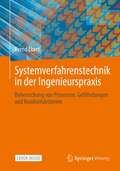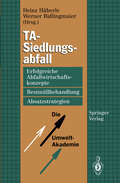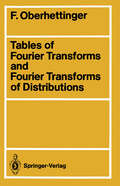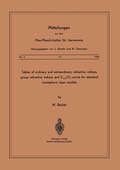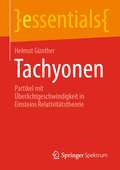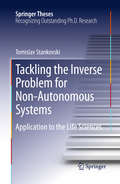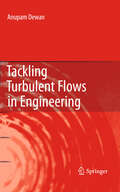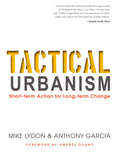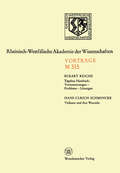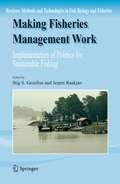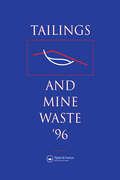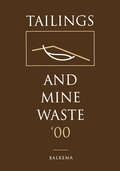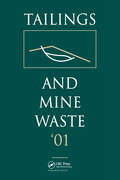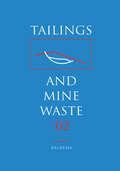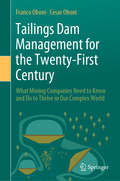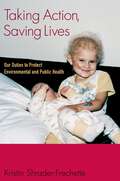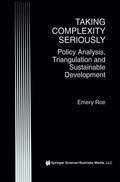- Table View
- List View
Systemverfahrenstechnik in der Ingenieurspraxis: Beherrschung von Prozessen, Gefährdungen und Reinheitskriterien
by Bernd EbertDas Buch behandelt die für das Optimum verfahrenstechnischer Prozesse unerlässliche System-Betrachtung. Diese sollte nicht nur für den „reinen“ Prozess erfolgen, sondern für den gesamten Lebenszyklus technischer Anlagen – vom Entwurf eines Prozesses bis zur Optimierung im laufenden Betrieb. Dabei kommt es nicht nur auf den Normalbetrieb an (wie häufig bei Simulationen betrachtet), sondern auch auf An- und Abfahrprozesse, das Havarie-/Störungsverhalten der Prozesse, die Reinigungsabläufe, Sicherheitsmaßnahmen usw. Geeignete Analyse- und Betrachtungsmethoden werden dazu vorgestellt, die sich in langjähriger Planungs- und Betriebspraxis herausgebildet haben. Hierzu zählen u.a. Risikoanalysen, Zeitdynamik- und Zuverlässigkeitsmethoden; deren theoretischer Ansatz wird mit ihrer praktischen Anwendbarkeit verbunden. Auch Aspekte wie Industrie 4.0 und Prozessänderungen bei laufenden Anlagen werden betrachtet. Damit soll ein Beitrag sowohl für die Ingenieurausbildung, die technische Betriebsbetreuung als auch für die Projektabwicklung geleistet werden.
Szegő's Theorem and Its Descendants: Spectral Theory for L2 Perturbations of Orthogonal Polynomials
by Barry SimonThis book presents a comprehensive overview of the sum rule approach to spectral analysis of orthogonal polynomials, which derives from Gábor Szego's classic 1915 theorem and its 1920 extension. Barry Simon emphasizes necessary and sufficient conditions, and provides mathematical background that until now has been available only in journals. Topics include background from the theory of meromorphic functions on hyperelliptic surfaces and the study of covering maps of the Riemann sphere with a finite number of slits removed. This allows for the first book-length treatment of orthogonal polynomials for measures supported on a finite number of intervals on the real line. In addition to the Szego and Killip-Simon theorems for orthogonal polynomials on the unit circle (OPUC) and orthogonal polynomials on the real line (OPRL), Simon covers Toda lattices, the moment problem, and Jacobi operators on the Bethe lattice. Recent work on applications of universality of the CD kernel to obtain detailed asymptotics on the fine structure of the zeros is also included. The book places special emphasis on OPRL, which makes it the essential companion volume to the author's earlier books on OPUC.
Szegő's Theorem and Its Descendants: Spectral Theory for L2 Perturbations of Orthogonal Polynomials
by Barry SimonThis book presents a comprehensive overview of the sum rule approach to spectral analysis of orthogonal polynomials, which derives from Gábor Szego's classic 1915 theorem and its 1920 extension. Barry Simon emphasizes necessary and sufficient conditions, and provides mathematical background that until now has been available only in journals. Topics include background from the theory of meromorphic functions on hyperelliptic surfaces and the study of covering maps of the Riemann sphere with a finite number of slits removed. This allows for the first book-length treatment of orthogonal polynomials for measures supported on a finite number of intervals on the real line. In addition to the Szego and Killip-Simon theorems for orthogonal polynomials on the unit circle (OPUC) and orthogonal polynomials on the real line (OPRL), Simon covers Toda lattices, the moment problem, and Jacobi operators on the Bethe lattice. Recent work on applications of universality of the CD kernel to obtain detailed asymptotics on the fine structure of the zeros is also included. The book places special emphasis on OPRL, which makes it the essential companion volume to the author's earlier books on OPUC.
TA-Siedlungsabfall: Erfolgreiche Abfallwirtschaftskonzepte, Restmüllbehandlung, Absatzstrategien
by Heinz Häberle Werner BidlingmaierTables of Ordinary and Extraordinary Refractive Indices, Group Refractive Indices and h’o,x (Mitteilungen aus dem Max-Planck-Institut für Aeronomie #4)
by W. BeckerThe N(h)-Working Party, a Group in Commission III of URS! (URS! Information Bulletin No. 112, p. 12) suggested these calculations of ordinary and extraordinary refractive indices n , vertical group refractive indices c/U , and virtual o,x o,x 1 heights h (f), for an Epstein, cosine and parabolic layer model. c ist the free 0 X 1 space velocity of light . U and U denote vertical ordinary and extraordinary 0 X group velocities. The data are intended to facilitate real height (h) computations from 1 1 observed, h (f)-traces. Especially the h (f)-data are intended also to allow o,x o,x for tests of existing reduction methods. For ionization minimum investigations an additional set of tables is presented. These tables represent the virtual paths 1 6 h (f) of sounding pulses which penetrate an ionospheric layer of parabolic o,x 1 shape; they can be used together with the abovementioned standard h (f)-curves o,x 1 to give ordinary and extraordinary h (f)-traces for any combination of a lower O, X parabolic layer and an upper Epstein, cosine or parabolic electron density distribution. Ordinary group refractive index tables have already been published by D. H. SHINN [ 1] 1 and by Vv. BECKER [ 2] • Their value s of cp , the angle of inclination of the earth s magnetic field, are slightly different from those used here. These tables may be used 1 as additional sets for interpolation purposes. D. H.
Tachyonen: Partikel mit Überlichtgeschwindigkeit in Einsteins Relativitätstheorie (essentials)
by Helmut GüntherPartikel, die sich permanent mit Überlichtgeschwindigkeit bewegen, heißen Tachyonen. Die zeitliche Reihenfolge der Endpunkte ihrer Bewegung ist vom Bezugssystem abhängig. Tachyonen können keine Nachricht übertragen, vermitteln aber über beliebig große Entfernungen einen Zusammenhang, ohne dass die Kausalität verletzt wird. Damit besprechen wir das Einstein-Podolsky-Rosen Paradoxon. Ein Teilchen wird durch seine Ruhmasse definiert, ein Tachyon durch einen Impulsparameter. Wir untersuchen Stoßprozesse mit Tachyonen. In Anlehnung an den Begriff des Quasiteilchens betrachten wir über einem Gitter auch Quasitachyonen. Wir erklären die Geschichte mit Schrödingers Katze.
Tackling the Inverse Problem for Non-Autonomous Systems: Application to the Life Sciences (Springer Theses)
by Tomislav StankovskiThis thesis presents a new method for following evolving interactions between coupled oscillatory systems of the kind that abound in nature. Examples range from the subcellular level, to ecosystems, through climate dynamics, to the movements of planets and stars. Such systems mutually interact, adjusting their internal clocks, and may correspondingly move between synchronized and non-synchronized states. The thesis describes a way of using Bayesian inference to exploit the presence of random fluctuations, thus analyzing these processes in unprecedented detail. It first develops the basic theory of interacting oscillators whose frequencies are non-constant, and then applies it to the human heart and lungs as an example. Their coupling function can be used to follow with great precision the transitions into and out of synchronization. The method described has the potential to illuminate the ageing process as well as to improve diagnostics in cardiology, anesthesiology and neuroscience, and yields insights into a wide diversity of natural processes.
Tackling Turbulent Flows in Engineering
by Anupam DewanThe emphasis of this book is on engineering aspects of fluid turbulence. The book explains for example how to tackle turbulence in industrial applications. It is useful to several disciplines, such as, mechanical, civil, chemical, aerospace engineers and also to professors, researchers, beginners, under graduates and post graduates. The following issues are emphasized in the book: - Modeling and computations of engineering flows: The author discusses in detail the quantities of interest for engineering turbulent flows and how to select an appropriate turbulence model; Also, a treatment of the selection of appropriate boundary conditions for the CFD simulations is given. - Modeling of turbulent convective heat transfer: This is encountered in several practical situations. It basically needs discussion on issues of treatment of walls and turbulent heat fluxes. - Modeling of buoyancy driven flows, for example, smoke issuing from chimney, pollutant discharge into water bodies, etc
Tactical Urbanism: Short-term Action For Long-term Change
by Mike Lydon Anthony GarciaShort-term, community-based projects—from pop-up parks to open streets initiatives—have become a powerful and adaptable new tool of urban activists, planners, and policy-makers seeking to drive lasting improvements in their cities and beyond. These quick, often low-cost, and creative projects are the essence of the Tactical Urbanism movement. Whether creating vibrant plazas seemingly overnight or re-imagining parking spaces as neighborhood gathering places, they offer a way to gain public and government support for investing in permanent projects, inspiring residents and civic leaders to experience and shape urban spaces in a new way.Tactical Urbanism, written by Mike Lydon and Anthony Garcia, two founders of the movement, promises to be the foundational guide for urban transformation. The authors begin with an in-depth history of the Tactical Urbanism movement and its place among other social, political, and urban planning trends, and a detailed set of case studies demonstrate the breadth and scalability of tactical urbanism interventions. Finally, the book provides a detailed toolkit for conceiving, planning, and carrying out projects, including how to adapt them based on local needs and challenges.Tactical Urbanism will inspire and empower a new generation of engaged citizens, urban designers, land use planners, architects, and policymakers to become key actors in the transformation of their communities.
Tafeln und Formeln aus Astronomie und Geodäsie für die Hand des Forschungsreisenden, Geographen, Astronomen und Geodäten
by Carl Wilhelm WirtzDieser Buchtitel ist Teil des Digitalisierungsprojekts Springer Book Archives mit Publikationen, die seit den Anfängen des Verlags von 1842 erschienen sind. Der Verlag stellt mit diesem Archiv Quellen für die historische wie auch die disziplingeschichtliche Forschung zur Verfügung, die jeweils im historischen Kontext betrachtet werden müssen. Dieser Titel erschien in der Zeit vor 1945 und wird daher in seiner zeittypischen politisch-ideologischen Ausrichtung vom Verlag nicht beworben.
Tagebau Hambach: 292. Sitzung am 2. Dezember 1981 in Düsseldorf (Rheinisch-Westfälische Akademie der Wissenschaften #315)
by Eckart ReicheTagging and Tracking of Marine Animals with Electronic Devices (Reviews: Methods and Technologies in Fish Biology and Fisheries #9)
by Jennifer L. Nielsen Haritz Arrizabalaga Nuno Fragoso Alistair Hobday Molly Lutcavage John SibertThe 2nd international tagging and tracking symposium was held in San Sebastian, Spain, in October 2007, seven years after the first symposium was held in Hawaii in 2000 (Sibert and Nielsen 2001). In the intervening seven years, there have been major advances in both the capability and reliability of electronic tags and analytical approaches for geolocation of tagged animals in marine habitats. Advances such as increased data storage capacity, sensor development, and tag miniaturization have allowed researchers to track a much wider array of marine animals, not just large and charismatic species. Importantly, data returned by these tags are now being used in population analyses and movement simulations that can be directly utilized in stock assessments and other management applications. Papers in this volume are divided into three sections, the first describing insights into behavior achieved using acoustic, archival, and novel tags, the second reporting on advances in methods of geolocation, while the final section includes contributions where tag data have been used in management of marine species. Accurate documentation of animal movements and behaviors in critical marine habitats are impossible to obtain with other technologies. The management and conservation of marine species are critical in today’s changing ocean environment and as electronic tags become more accurate and functional for a diversity of organisms their application continues to grow, setting new standards in science and technology.
Tailings and Mine Waste 1996
by Colorado State Colorado State UniversityPresents papers on mine and mill tailings and mine waste, as well as current and future issues facing the mining and environmental communities. Subjects related to technical capabilities and developments, regulations and environmental concerns are included.
Tailings and Mine Waste 1996
by Colorado State UniversityPresents papers on mine and mill tailings and mine waste, as well as current and future issues facing the mining and environmental communities. Subjects related to technical capabilities and developments, regulations and environmental concerns are included.
Tailings and Mine Waste 2000
by A. A. BalkemaThe objective of this text is to provide information on mill tailings and mine waste, and to discuss current and future issues facing the mining and environmental communities. With over 60 papers included.
Tailings and Mine Waste 2000
by A. A. A. A. Balkema PublishersThe objective of this text is to provide information on mill tailings and mine waste, and to discuss current and future issues facing the mining and environmental communities. With over 60 papers included.
Tailings and Mine Waste 2001
by NoneThese papers focus on mine and mill tillings and mine waste. The work also contains information on subjects related to: regulations, technical capacities and developments. This guide identifies the current and future issues facing the mining and enviromental concerns.
Tailings and Mine Waste 2001
by A. A. A. A. Balkema PublishersThese papers focus on mine and mill tillings and mine waste. The work also contains information on subjects related to: regulations, technical capacities and developments. This guide identifies the current and future issues facing the mining and enviromental concerns.
Tailings and Mine Waste 2002: Proceedings of the 9th International Conference, Fort Collins, Colorado,
by Symposium EditorsThe proceedings in this work present 60 papers on mine and mill tailings and mine waste, as well as current and future issues facing the mining and environmental communities. This includes matters dealing with technical capabilities and developments, regulations, and environmental concerns.
Tailings and Mine Waste 2002: Proceedings of the 9th International Conference, Fort Collins, Colorado,
by Symposium Symposium EditorsThe proceedings in this work present 60 papers on mine and mill tailings and mine waste, as well as current and future issues facing the mining and environmental communities. This includes matters dealing with technical capabilities and developments, regulations, and environmental concerns.
Tailings Dam Management for the Twenty-First Century: What Mining Companies Need to Know and Do to Thrive in Our Complex World
by Franco Oboni Cesar OboniThis book presents a comprehensive approach to address the need to improve the design of tailings dams, their management and the regulation of tailings management facilities to reduce, and eventually eliminate, the risk of such facilities failing. The scope of the challenge is well documented in the report by the United Nations Environment Program (UNEP) and GRID Arendal entitled “Mine Tailings Storage: Safety Is No Accident,” which was released in October 2017. The report recommends that “Regulators, industry and communities should adopt a shared, zero-failure objective to tailings storage facilities…” and identifies several areas where further improvements are required. In this context, the application of cutting-edge risk-assessment methodologies and risk-management practices can contribute to a significant reduction and eventual elimination of dam failures through Risk Informed Decision Making. As such, the book focuses on identifying and describing the risk-assessment approaches and risk-management practices that need to be implemented in order to develop a way forward to achieve socially acceptable levels of tailings dam risk.
Take Back Higher Education: Race, Youth, and the Crisis of Democracy in the Post-Civil Rights Era
by H. GirouxAt the beginning for the new millennium, higher education is under siege. No longer viewed as a public good, higher education increasingly is besieged by corporate, right-wing and conservative ideologies that want to decouple higher education from its legacy of educating students to be critical and autonomous citizens, imbued with democratic and public values. The greatest danger faced by higher education comes from the focus of global neo-liberalism and the return of educational apartheid. Through the power of racial backlash, the war on youth, deregulation, commercialism, and privatization, neo-liberalism wages a vicious assault on all of those public spheres and goods not controlled by the logic of market relations and profit margins. Take Back Higher Education argues that if higher education is going to meet the challenges of a democratic future, it will have to confront neo-liberalism, racism, and the shredding of the social contract.
Taking Action, Saving Lives: Our Duties to Protect Environmental and Public Health (Environmental Ethics and Science Policy Series)
by Kristin Shrader-FrechetteIn the United States alone, industrial and agricultural toxins account for about 60,000 avoidable cancer deaths annually. Pollution-related health costs to Americans are similarly staggering: $13 billion a year from asthma, $351 billion from cardiovascular disease, and $240 billion from occupational disease and injury. Most troubling, children, the poor, and minorities bear the brunt of these health tragedies. Why, asks Kristin Shrader-Frechette, has the government failed to protect us, and what can we do about it? In this book, at once brilliant and accessible, Shrader-Frechette reveals how politicians, campaign contributors, and lobbyists--and their power over media, advertising, and public relations--have conspired to cover up environmental disease and death. She also shows how science and regulators themselves are frequently "captured" by well-funded polluters and special interests. But most important, the author puts both the blame--and the solution--on the shoulders of ordinary citizens. She argues that everyone, especially in a democracy, has a duty to help prevent avoidable environmental deaths, to remain informed about, and involved in, public-health and environmental decision-making. Toward this end, she outlines specific, concrete ways in which people can contribute to life-saving reforms, many of them building on recommendations of the American Public Health Association. As disturbing as it is, Shrader-Frechette's message is ultimately hopeful. Calling for a new "democratic revolution," she reminds us that while only a fraction of the early colonists supported the American Revolution, that tiny group managed to change the world. Her book embodies the conviction that we can do the same for environmental health, particularly if citizens become the change they seek. "Timely, accessible, and written with enviable clarity and passion. A distinguished philosopher sounds an ethical call to arms to prevent illness and death from pollution." --Sheila Jasanoff, Harvard University "Influential and impressive. A must-read." --Nicholas A. Ashford, Massachusetts Institute of Technology "By one of America's foremost philosophers and public intellectuals; immensely readable, courageous, often startling, insightful." --Richard Hiskes, University of Connecticut "Like Rachel Carson's Silent Spring--brilliant, brave." --Sylvia Hood Washington, University of Illinois, Chicago "A blistering account of how advocacy must be brought to bear on issues of justice and public health." -- Jeffrey Kahn, University of Minnesota "No other author can so forcefully bring together ethical analysis, government policy, and environmental science. Outstanding." --Colleen Moore, University of Wisconsin
Taking Complexity Seriously: Policy Analysis, Triangulation and Sustainable Development
by Emery RoeTaking Complexity Seriously applies the advanced policy analysis technique of triangulation to what is now the world's most complex public policy challenge: sustainable development. One central problem of public policy analysis has been to find new ways of analyzing issues of increasing complexity and uncertainty. Triangulation is perhaps the best example of these novel techniques, as it uses various methods, databases, theories, and approaches to converge on what to do about the complex issue in question. Taking Complexity Seriously uses four different theoretical approaches (Girardian economics, cultural theory, critical theory, and the local justice framework) to triangulation in order to converge on answers to four major policy questions: What is sustainable development? Why is it an issue? What needs to be done? What can actually be done? These four approaches are used to analyze the sustainable development controversy that recently arose in the pages of Science magazine and the journal Ecological Applications. These different approaches prove highly potent in defamiliarizing conventional wisdom about sustainable development. Ultimately the different approaches will converge on novel answers to the four questions. The practical implications of these conclusions are drawn out at the end of Taking Complexity Seriously in a detailed case study of ecosystem management.
